Report on Macroeconomic Analysis of New Zealand's Economy
VerifiedAdded on 2019/10/31
|14
|2653
|253
Report
AI Summary
This report provides a comprehensive macroeconomic analysis of New Zealand's economy. It begins with an executive summary and introduction to the country's economic standing, including its GDP and key sectors. The discussion section delves into the roles of fiscal and monetary policies, their instruments, and their impact on the economy. The report identifies core economic issues in New Zealand, such as income inequality, current account deficits, and the impact of the 2008 financial crisis, including recent issues like the housing crisis and unemployment. It further examines the macroeconomic policies adopted between 2016 and 2017, focusing on monetary policies like the Official Cash Rate (OCR) and fiscal policies related to government expenditure and taxation. The analysis includes the effects of these policies on national economic performance, such as public debt, tourism, and employment. The report concludes with an overview of the country's responsiveness to global economic downturns and the effectiveness of government policies in managing inflation, unemployment, and public debt.
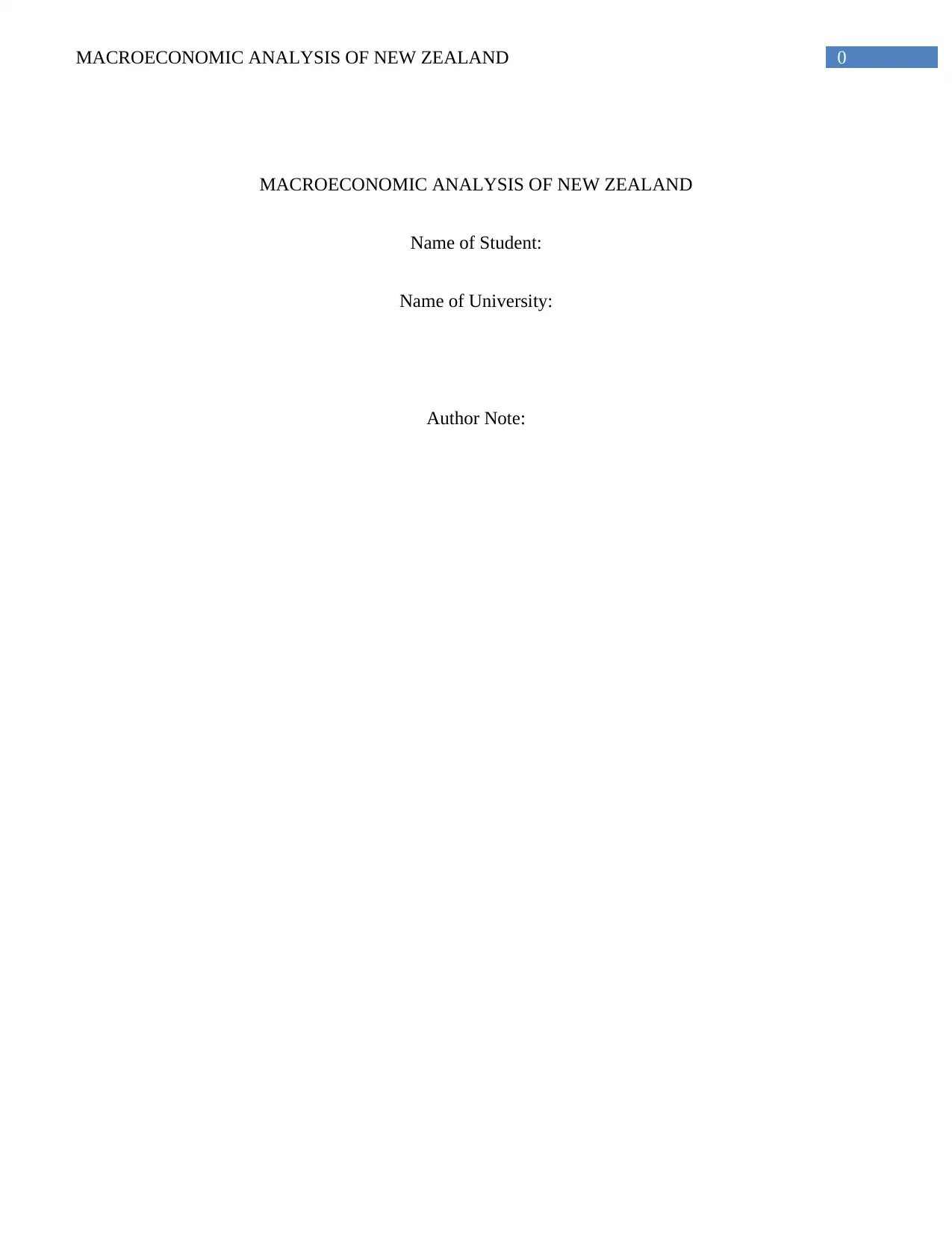
0MACROECONOMIC ANALYSIS OF NEW ZEALAND
MACROECONOMIC ANALYSIS OF NEW ZEALAND
Name of Student:
Name of University:
Author Note:
MACROECONOMIC ANALYSIS OF NEW ZEALAND
Name of Student:
Name of University:
Author Note:
Paraphrase This Document
Need a fresh take? Get an instant paraphrase of this document with our AI Paraphraser
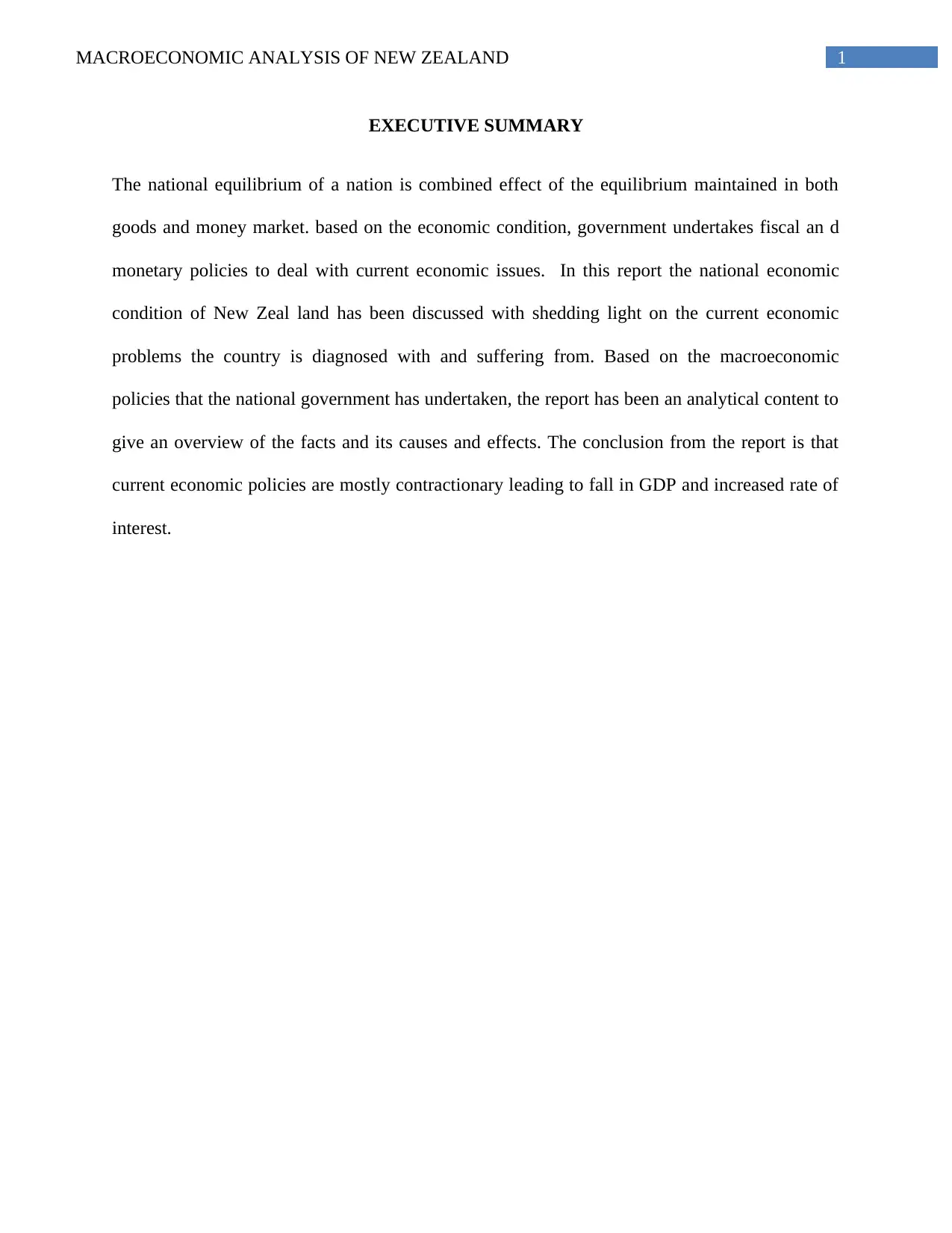
1MACROECONOMIC ANALYSIS OF NEW ZEALAND
EXECUTIVE SUMMARY
The national equilibrium of a nation is combined effect of the equilibrium maintained in both
goods and money market. based on the economic condition, government undertakes fiscal an d
monetary policies to deal with current economic issues. In this report the national economic
condition of New Zeal land has been discussed with shedding light on the current economic
problems the country is diagnosed with and suffering from. Based on the macroeconomic
policies that the national government has undertaken, the report has been an analytical content to
give an overview of the facts and its causes and effects. The conclusion from the report is that
current economic policies are mostly contractionary leading to fall in GDP and increased rate of
interest.
EXECUTIVE SUMMARY
The national equilibrium of a nation is combined effect of the equilibrium maintained in both
goods and money market. based on the economic condition, government undertakes fiscal an d
monetary policies to deal with current economic issues. In this report the national economic
condition of New Zeal land has been discussed with shedding light on the current economic
problems the country is diagnosed with and suffering from. Based on the macroeconomic
policies that the national government has undertaken, the report has been an analytical content to
give an overview of the facts and its causes and effects. The conclusion from the report is that
current economic policies are mostly contractionary leading to fall in GDP and increased rate of
interest.
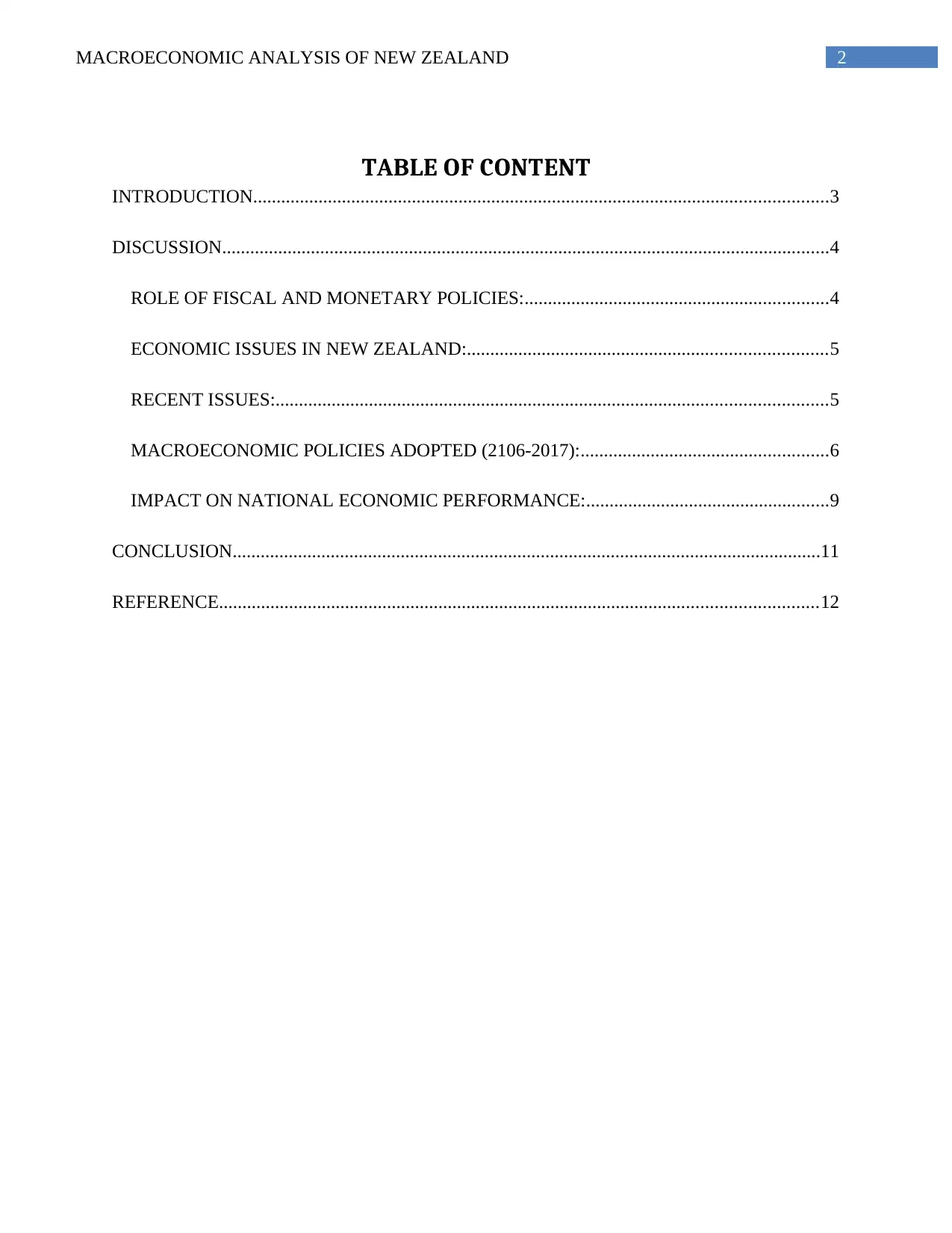
2MACROECONOMIC ANALYSIS OF NEW ZEALAND
TABLE OF CONTENT
INTRODUCTION...........................................................................................................................3
DISCUSSION..................................................................................................................................4
ROLE OF FISCAL AND MONETARY POLICIES:.................................................................4
ECONOMIC ISSUES IN NEW ZEALAND:.............................................................................5
RECENT ISSUES:......................................................................................................................5
MACROECONOMIC POLICIES ADOPTED (2106-2017):.....................................................6
IMPACT ON NATIONAL ECONOMIC PERFORMANCE:....................................................9
CONCLUSION..............................................................................................................................11
REFERENCE................................................................................................................................12
TABLE OF CONTENT
INTRODUCTION...........................................................................................................................3
DISCUSSION..................................................................................................................................4
ROLE OF FISCAL AND MONETARY POLICIES:.................................................................4
ECONOMIC ISSUES IN NEW ZEALAND:.............................................................................5
RECENT ISSUES:......................................................................................................................5
MACROECONOMIC POLICIES ADOPTED (2106-2017):.....................................................6
IMPACT ON NATIONAL ECONOMIC PERFORMANCE:....................................................9
CONCLUSION..............................................................................................................................11
REFERENCE................................................................................................................................12
⊘ This is a preview!⊘
Do you want full access?
Subscribe today to unlock all pages.

Trusted by 1+ million students worldwide
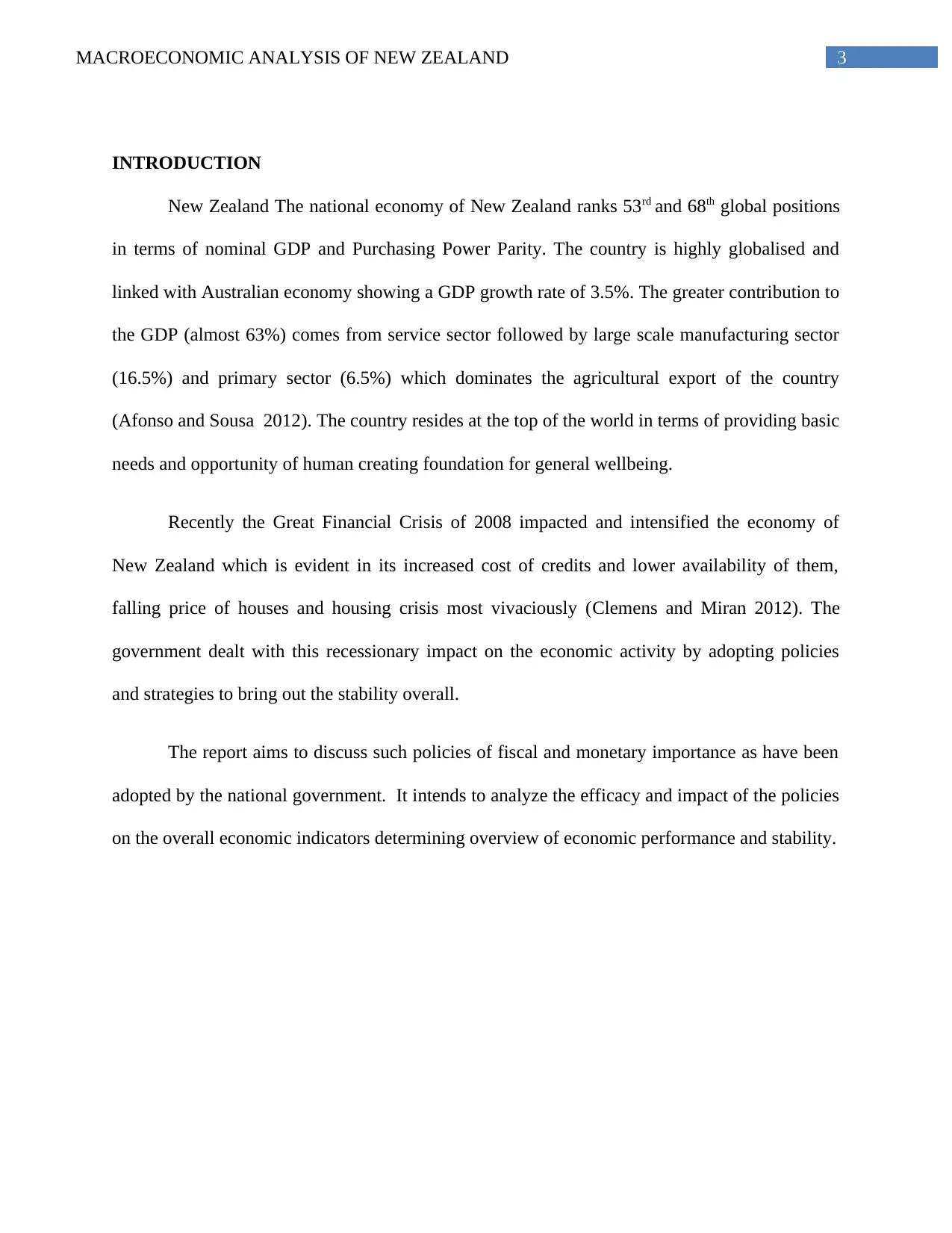
3MACROECONOMIC ANALYSIS OF NEW ZEALAND
INTRODUCTION
New Zealand The national economy of New Zealand ranks 53rd and 68th global positions
in terms of nominal GDP and Purchasing Power Parity. The country is highly globalised and
linked with Australian economy showing a GDP growth rate of 3.5%. The greater contribution to
the GDP (almost 63%) comes from service sector followed by large scale manufacturing sector
(16.5%) and primary sector (6.5%) which dominates the agricultural export of the country
(Afonso and Sousa 2012). The country resides at the top of the world in terms of providing basic
needs and opportunity of human creating foundation for general wellbeing.
Recently the Great Financial Crisis of 2008 impacted and intensified the economy of
New Zealand which is evident in its increased cost of credits and lower availability of them,
falling price of houses and housing crisis most vivaciously (Clemens and Miran 2012). The
government dealt with this recessionary impact on the economic activity by adopting policies
and strategies to bring out the stability overall.
The report aims to discuss such policies of fiscal and monetary importance as have been
adopted by the national government. It intends to analyze the efficacy and impact of the policies
on the overall economic indicators determining overview of economic performance and stability.
INTRODUCTION
New Zealand The national economy of New Zealand ranks 53rd and 68th global positions
in terms of nominal GDP and Purchasing Power Parity. The country is highly globalised and
linked with Australian economy showing a GDP growth rate of 3.5%. The greater contribution to
the GDP (almost 63%) comes from service sector followed by large scale manufacturing sector
(16.5%) and primary sector (6.5%) which dominates the agricultural export of the country
(Afonso and Sousa 2012). The country resides at the top of the world in terms of providing basic
needs and opportunity of human creating foundation for general wellbeing.
Recently the Great Financial Crisis of 2008 impacted and intensified the economy of
New Zealand which is evident in its increased cost of credits and lower availability of them,
falling price of houses and housing crisis most vivaciously (Clemens and Miran 2012). The
government dealt with this recessionary impact on the economic activity by adopting policies
and strategies to bring out the stability overall.
The report aims to discuss such policies of fiscal and monetary importance as have been
adopted by the national government. It intends to analyze the efficacy and impact of the policies
on the overall economic indicators determining overview of economic performance and stability.
Paraphrase This Document
Need a fresh take? Get an instant paraphrase of this document with our AI Paraphraser
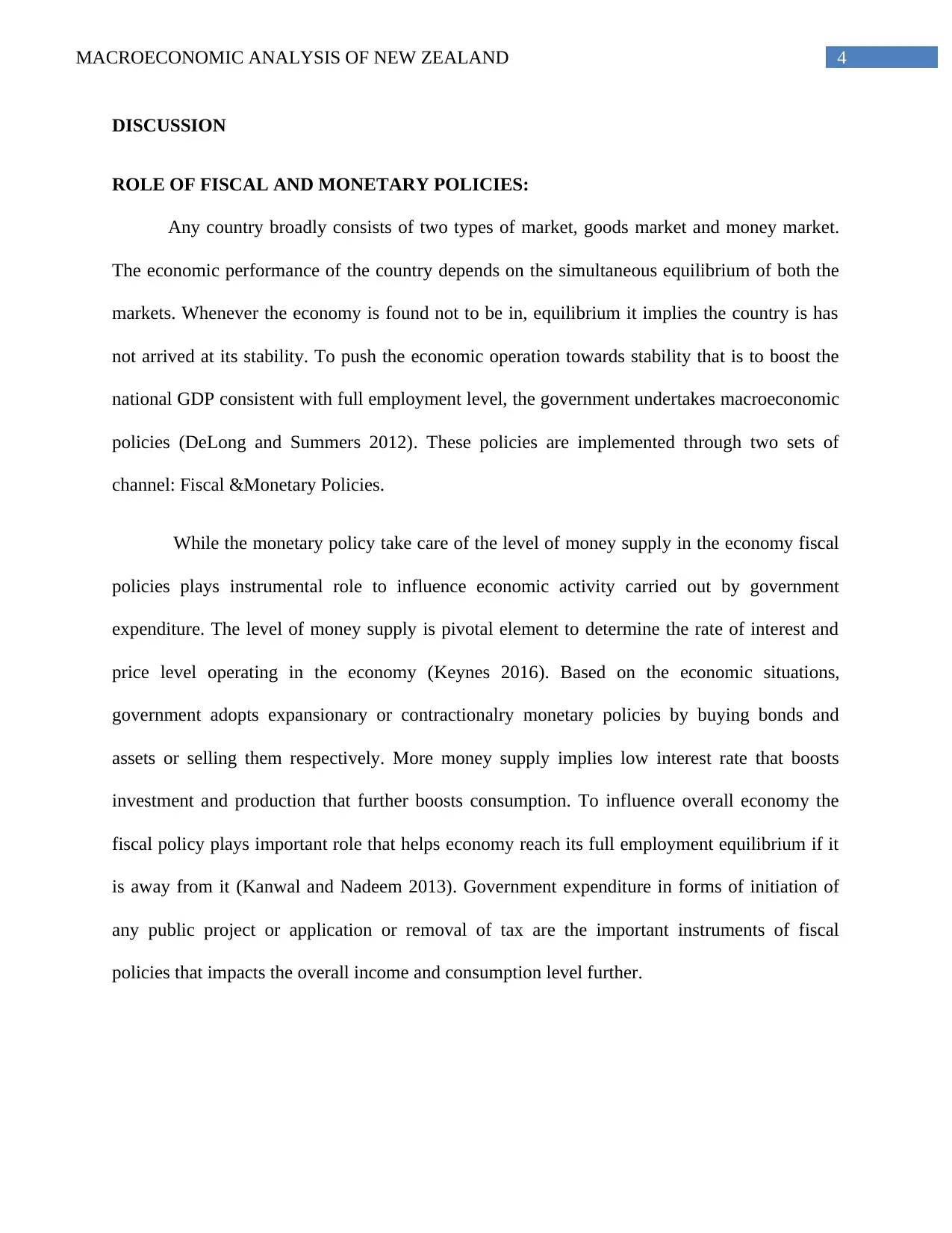
4MACROECONOMIC ANALYSIS OF NEW ZEALAND
DISCUSSION
ROLE OF FISCAL AND MONETARY POLICIES:
Any country broadly consists of two types of market, goods market and money market.
The economic performance of the country depends on the simultaneous equilibrium of both the
markets. Whenever the economy is found not to be in, equilibrium it implies the country is has
not arrived at its stability. To push the economic operation towards stability that is to boost the
national GDP consistent with full employment level, the government undertakes macroeconomic
policies (DeLong and Summers 2012). These policies are implemented through two sets of
channel: Fiscal &Monetary Policies.
While the monetary policy take care of the level of money supply in the economy fiscal
policies plays instrumental role to influence economic activity carried out by government
expenditure. The level of money supply is pivotal element to determine the rate of interest and
price level operating in the economy (Keynes 2016). Based on the economic situations,
government adopts expansionary or contractionalry monetary policies by buying bonds and
assets or selling them respectively. More money supply implies low interest rate that boosts
investment and production that further boosts consumption. To influence overall economy the
fiscal policy plays important role that helps economy reach its full employment equilibrium if it
is away from it (Kanwal and Nadeem 2013). Government expenditure in forms of initiation of
any public project or application or removal of tax are the important instruments of fiscal
policies that impacts the overall income and consumption level further.
DISCUSSION
ROLE OF FISCAL AND MONETARY POLICIES:
Any country broadly consists of two types of market, goods market and money market.
The economic performance of the country depends on the simultaneous equilibrium of both the
markets. Whenever the economy is found not to be in, equilibrium it implies the country is has
not arrived at its stability. To push the economic operation towards stability that is to boost the
national GDP consistent with full employment level, the government undertakes macroeconomic
policies (DeLong and Summers 2012). These policies are implemented through two sets of
channel: Fiscal &Monetary Policies.
While the monetary policy take care of the level of money supply in the economy fiscal
policies plays instrumental role to influence economic activity carried out by government
expenditure. The level of money supply is pivotal element to determine the rate of interest and
price level operating in the economy (Keynes 2016). Based on the economic situations,
government adopts expansionary or contractionalry monetary policies by buying bonds and
assets or selling them respectively. More money supply implies low interest rate that boosts
investment and production that further boosts consumption. To influence overall economy the
fiscal policy plays important role that helps economy reach its full employment equilibrium if it
is away from it (Kanwal and Nadeem 2013). Government expenditure in forms of initiation of
any public project or application or removal of tax are the important instruments of fiscal
policies that impacts the overall income and consumption level further.
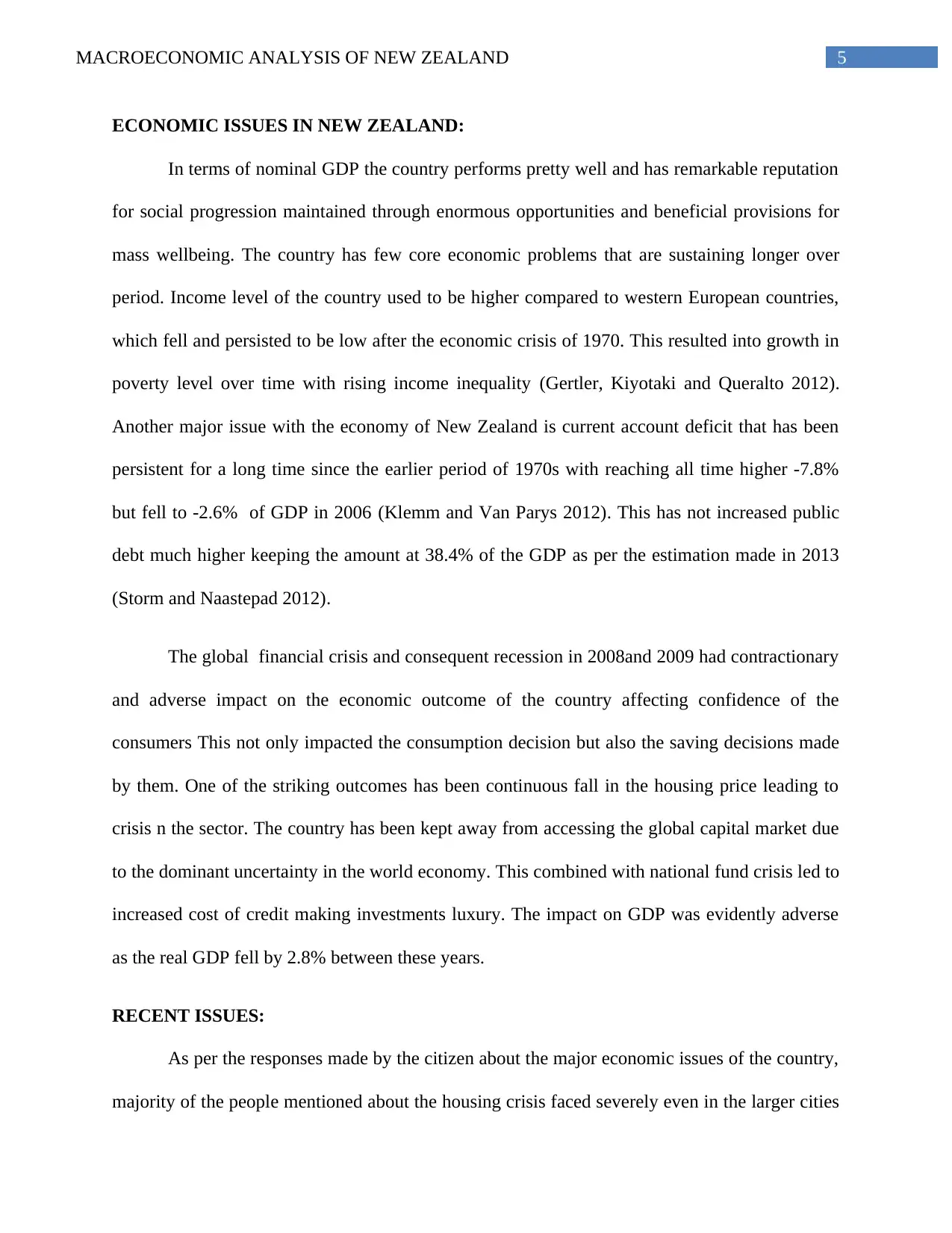
5MACROECONOMIC ANALYSIS OF NEW ZEALAND
ECONOMIC ISSUES IN NEW ZEALAND:
In terms of nominal GDP the country performs pretty well and has remarkable reputation
for social progression maintained through enormous opportunities and beneficial provisions for
mass wellbeing. The country has few core economic problems that are sustaining longer over
period. Income level of the country used to be higher compared to western European countries,
which fell and persisted to be low after the economic crisis of 1970. This resulted into growth in
poverty level over time with rising income inequality (Gertler, Kiyotaki and Queralto 2012).
Another major issue with the economy of New Zealand is current account deficit that has been
persistent for a long time since the earlier period of 1970s with reaching all time higher -7.8%
but fell to -2.6% of GDP in 2006 (Klemm and Van Parys 2012). This has not increased public
debt much higher keeping the amount at 38.4% of the GDP as per the estimation made in 2013
(Storm and Naastepad 2012).
The global financial crisis and consequent recession in 2008and 2009 had contractionary
and adverse impact on the economic outcome of the country affecting confidence of the
consumers This not only impacted the consumption decision but also the saving decisions made
by them. One of the striking outcomes has been continuous fall in the housing price leading to
crisis n the sector. The country has been kept away from accessing the global capital market due
to the dominant uncertainty in the world economy. This combined with national fund crisis led to
increased cost of credit making investments luxury. The impact on GDP was evidently adverse
as the real GDP fell by 2.8% between these years.
RECENT ISSUES:
As per the responses made by the citizen about the major economic issues of the country,
majority of the people mentioned about the housing crisis faced severely even in the larger cities
ECONOMIC ISSUES IN NEW ZEALAND:
In terms of nominal GDP the country performs pretty well and has remarkable reputation
for social progression maintained through enormous opportunities and beneficial provisions for
mass wellbeing. The country has few core economic problems that are sustaining longer over
period. Income level of the country used to be higher compared to western European countries,
which fell and persisted to be low after the economic crisis of 1970. This resulted into growth in
poverty level over time with rising income inequality (Gertler, Kiyotaki and Queralto 2012).
Another major issue with the economy of New Zealand is current account deficit that has been
persistent for a long time since the earlier period of 1970s with reaching all time higher -7.8%
but fell to -2.6% of GDP in 2006 (Klemm and Van Parys 2012). This has not increased public
debt much higher keeping the amount at 38.4% of the GDP as per the estimation made in 2013
(Storm and Naastepad 2012).
The global financial crisis and consequent recession in 2008and 2009 had contractionary
and adverse impact on the economic outcome of the country affecting confidence of the
consumers This not only impacted the consumption decision but also the saving decisions made
by them. One of the striking outcomes has been continuous fall in the housing price leading to
crisis n the sector. The country has been kept away from accessing the global capital market due
to the dominant uncertainty in the world economy. This combined with national fund crisis led to
increased cost of credit making investments luxury. The impact on GDP was evidently adverse
as the real GDP fell by 2.8% between these years.
RECENT ISSUES:
As per the responses made by the citizen about the major economic issues of the country,
majority of the people mentioned about the housing crisis faced severely even in the larger cities
⊘ This is a preview!⊘
Do you want full access?
Subscribe today to unlock all pages.

Trusted by 1+ million students worldwide
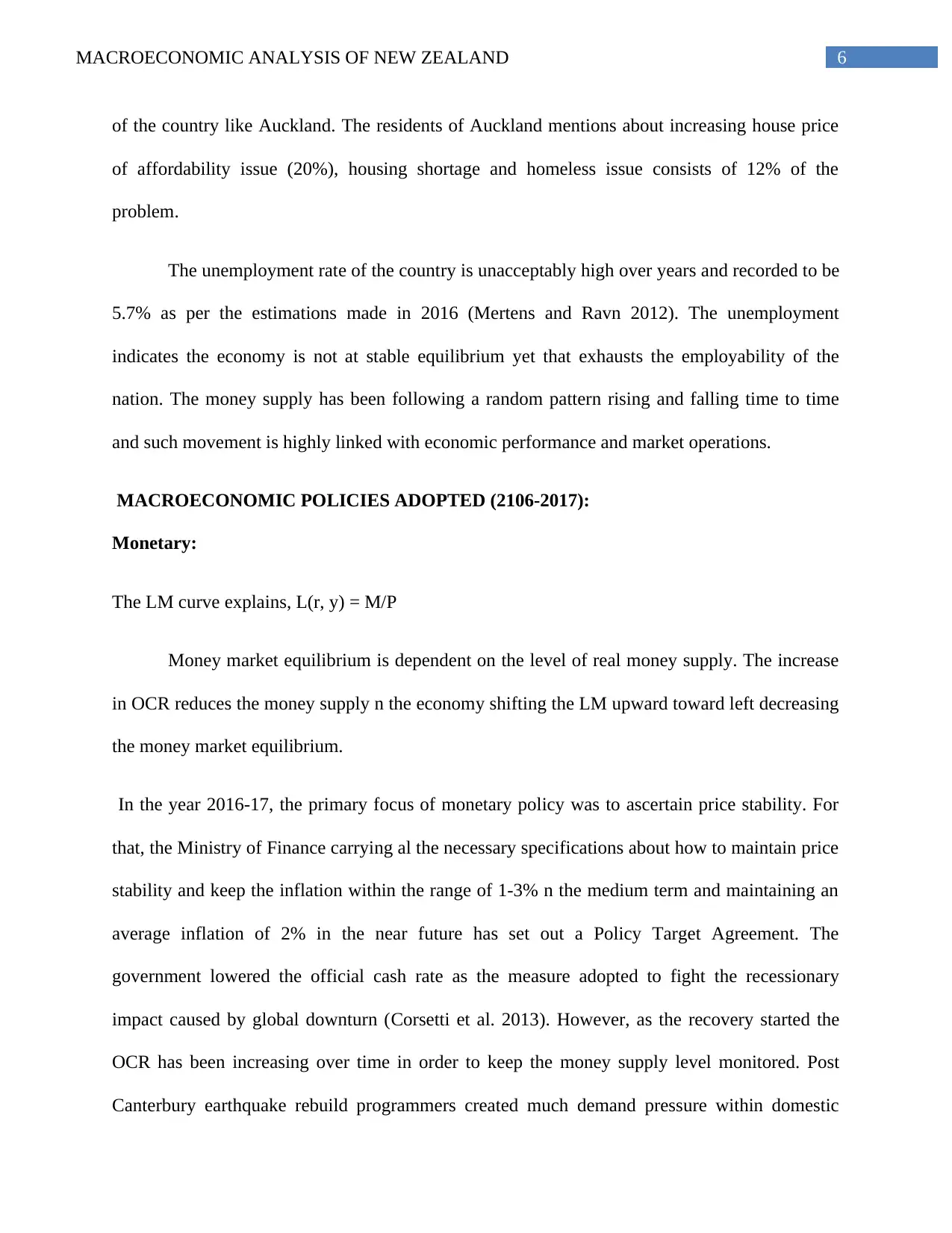
6MACROECONOMIC ANALYSIS OF NEW ZEALAND
of the country like Auckland. The residents of Auckland mentions about increasing house price
of affordability issue (20%), housing shortage and homeless issue consists of 12% of the
problem.
The unemployment rate of the country is unacceptably high over years and recorded to be
5.7% as per the estimations made in 2016 (Mertens and Ravn 2012). The unemployment
indicates the economy is not at stable equilibrium yet that exhausts the employability of the
nation. The money supply has been following a random pattern rising and falling time to time
and such movement is highly linked with economic performance and market operations.
MACROECONOMIC POLICIES ADOPTED (2106-2017):
Monetary:
The LM curve explains, L(r, y) = M/P
Money market equilibrium is dependent on the level of real money supply. The increase
in OCR reduces the money supply n the economy shifting the LM upward toward left decreasing
the money market equilibrium.
In the year 2016-17, the primary focus of monetary policy was to ascertain price stability. For
that, the Ministry of Finance carrying al the necessary specifications about how to maintain price
stability and keep the inflation within the range of 1-3% n the medium term and maintaining an
average inflation of 2% in the near future has set out a Policy Target Agreement. The
government lowered the official cash rate as the measure adopted to fight the recessionary
impact caused by global downturn (Corsetti et al. 2013). However, as the recovery started the
OCR has been increasing over time in order to keep the money supply level monitored. Post
Canterbury earthquake rebuild programmers created much demand pressure within domestic
of the country like Auckland. The residents of Auckland mentions about increasing house price
of affordability issue (20%), housing shortage and homeless issue consists of 12% of the
problem.
The unemployment rate of the country is unacceptably high over years and recorded to be
5.7% as per the estimations made in 2016 (Mertens and Ravn 2012). The unemployment
indicates the economy is not at stable equilibrium yet that exhausts the employability of the
nation. The money supply has been following a random pattern rising and falling time to time
and such movement is highly linked with economic performance and market operations.
MACROECONOMIC POLICIES ADOPTED (2106-2017):
Monetary:
The LM curve explains, L(r, y) = M/P
Money market equilibrium is dependent on the level of real money supply. The increase
in OCR reduces the money supply n the economy shifting the LM upward toward left decreasing
the money market equilibrium.
In the year 2016-17, the primary focus of monetary policy was to ascertain price stability. For
that, the Ministry of Finance carrying al the necessary specifications about how to maintain price
stability and keep the inflation within the range of 1-3% n the medium term and maintaining an
average inflation of 2% in the near future has set out a Policy Target Agreement. The
government lowered the official cash rate as the measure adopted to fight the recessionary
impact caused by global downturn (Corsetti et al. 2013). However, as the recovery started the
OCR has been increasing over time in order to keep the money supply level monitored. Post
Canterbury earthquake rebuild programmers created much demand pressure within domestic
Paraphrase This Document
Need a fresh take? Get an instant paraphrase of this document with our AI Paraphraser
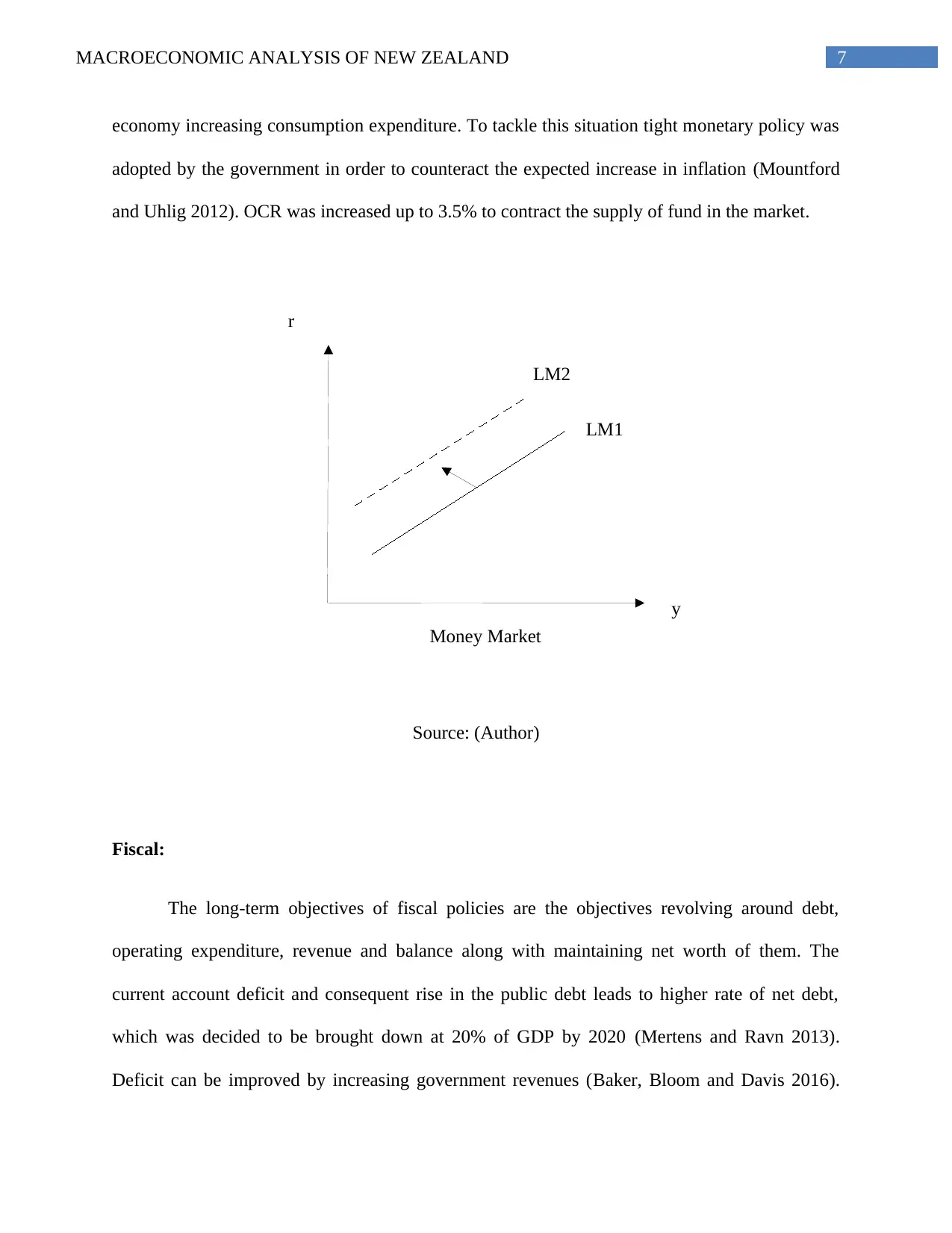
7MACROECONOMIC ANALYSIS OF NEW ZEALAND
r
y
LM1
LM2
Money Market
economy increasing consumption expenditure. To tackle this situation tight monetary policy was
adopted by the government in order to counteract the expected increase in inflation (Mountford
and Uhlig 2012). OCR was increased up to 3.5% to contract the supply of fund in the market.
Source: (Author)
Fiscal:
The long-term objectives of fiscal policies are the objectives revolving around debt,
operating expenditure, revenue and balance along with maintaining net worth of them. The
current account deficit and consequent rise in the public debt leads to higher rate of net debt,
which was decided to be brought down at 20% of GDP by 2020 (Mertens and Ravn 2013).
Deficit can be improved by increasing government revenues (Baker, Bloom and Davis 2016).
r
y
LM1
LM2
Money Market
economy increasing consumption expenditure. To tackle this situation tight monetary policy was
adopted by the government in order to counteract the expected increase in inflation (Mountford
and Uhlig 2012). OCR was increased up to 3.5% to contract the supply of fund in the market.
Source: (Author)
Fiscal:
The long-term objectives of fiscal policies are the objectives revolving around debt,
operating expenditure, revenue and balance along with maintaining net worth of them. The
current account deficit and consequent rise in the public debt leads to higher rate of net debt,
which was decided to be brought down at 20% of GDP by 2020 (Mertens and Ravn 2013).
Deficit can be improved by increasing government revenues (Baker, Bloom and Davis 2016).
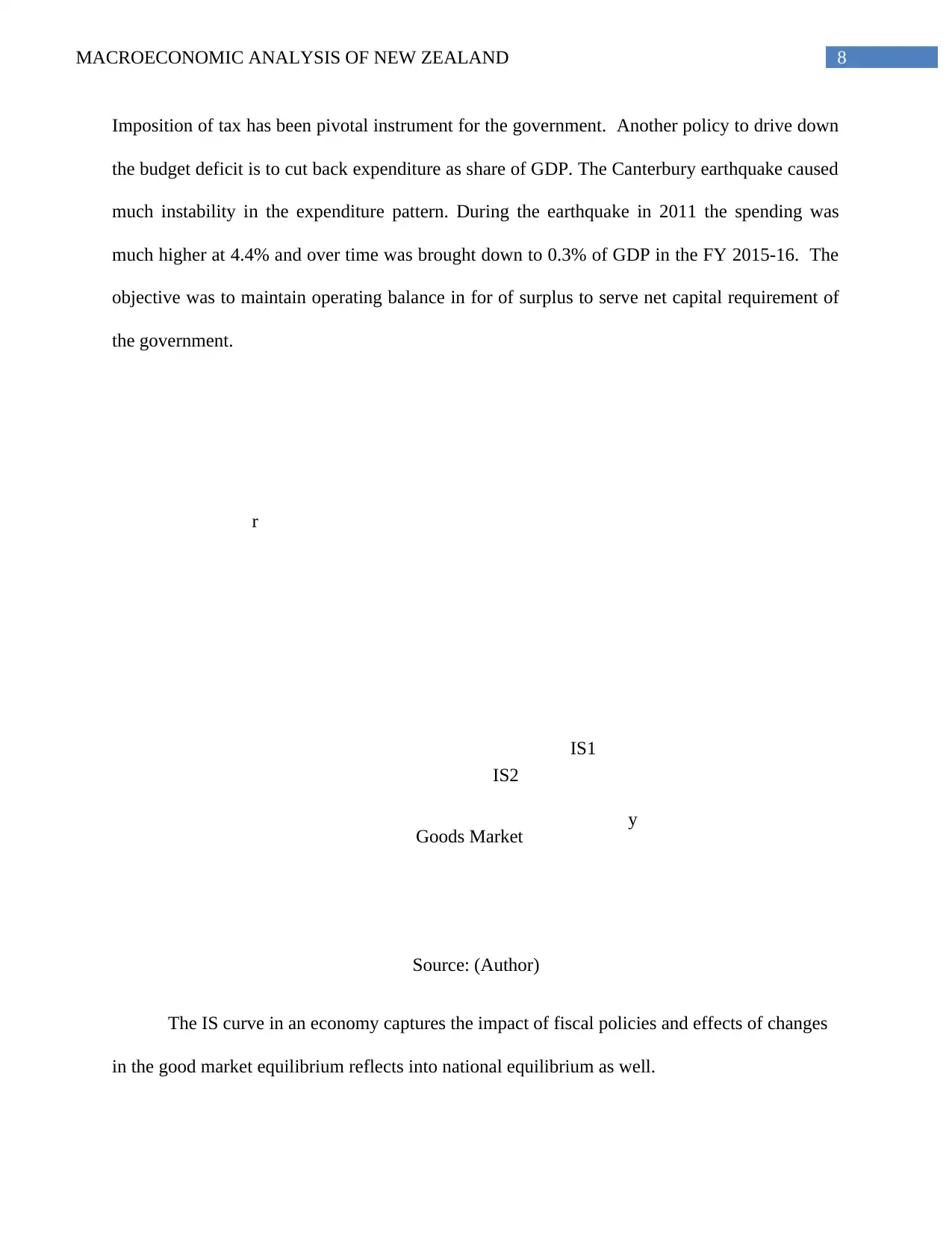
8MACROECONOMIC ANALYSIS OF NEW ZEALAND
IS1
IS2
y
r
Goods Market
Imposition of tax has been pivotal instrument for the government. Another policy to drive down
the budget deficit is to cut back expenditure as share of GDP. The Canterbury earthquake caused
much instability in the expenditure pattern. During the earthquake in 2011 the spending was
much higher at 4.4% and over time was brought down to 0.3% of GDP in the FY 2015-16. The
objective was to maintain operating balance in for of surplus to serve net capital requirement of
the government.
Source: (Author)
The IS curve in an economy captures the impact of fiscal policies and effects of changes
in the good market equilibrium reflects into national equilibrium as well.
IS1
IS2
y
r
Goods Market
Imposition of tax has been pivotal instrument for the government. Another policy to drive down
the budget deficit is to cut back expenditure as share of GDP. The Canterbury earthquake caused
much instability in the expenditure pattern. During the earthquake in 2011 the spending was
much higher at 4.4% and over time was brought down to 0.3% of GDP in the FY 2015-16. The
objective was to maintain operating balance in for of surplus to serve net capital requirement of
the government.
Source: (Author)
The IS curve in an economy captures the impact of fiscal policies and effects of changes
in the good market equilibrium reflects into national equilibrium as well.
⊘ This is a preview!⊘
Do you want full access?
Subscribe today to unlock all pages.

Trusted by 1+ million students worldwide
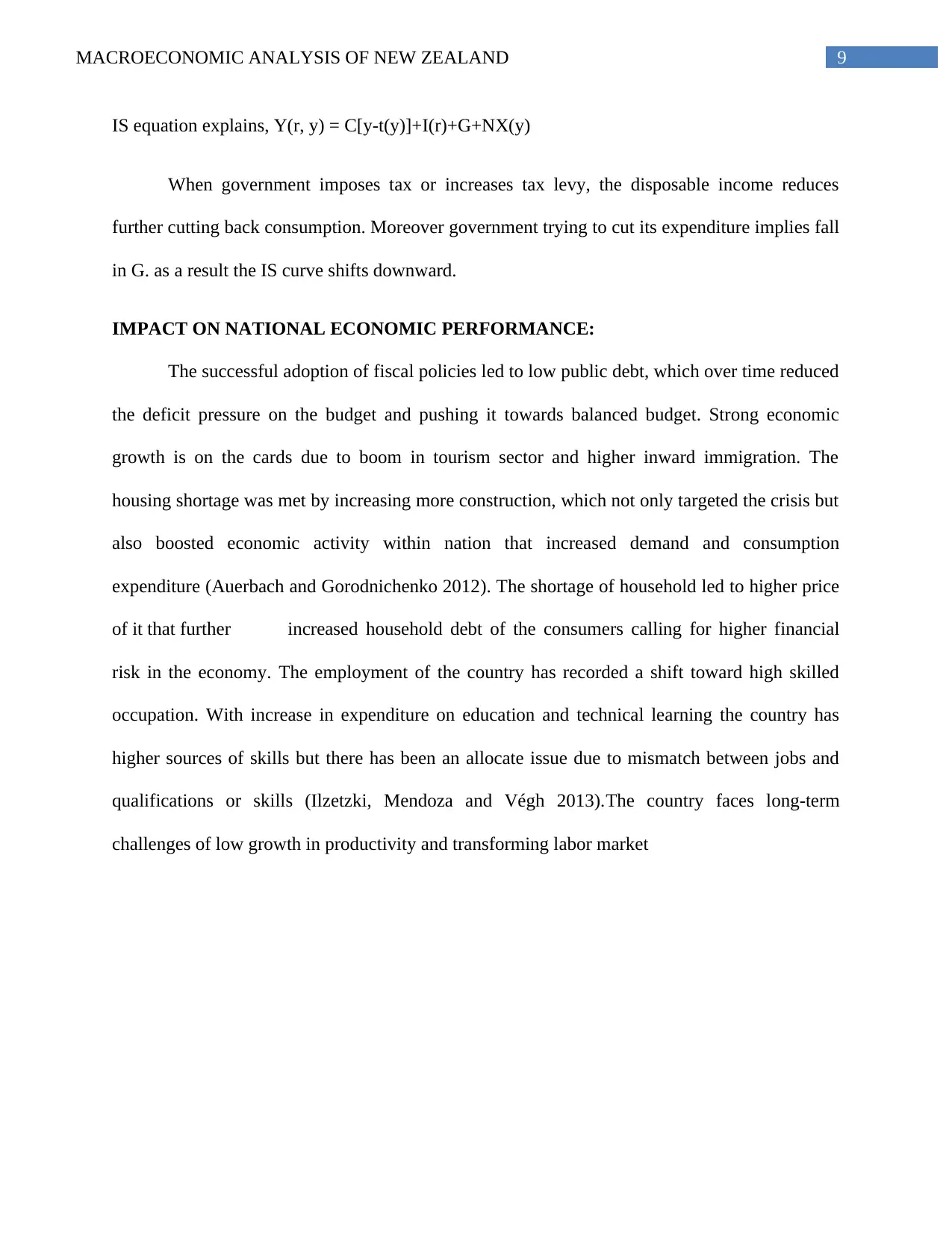
9MACROECONOMIC ANALYSIS OF NEW ZEALAND
IS equation explains, Y(r, y) = C[y-t(y)]+I(r)+G+NX(y)
When government imposes tax or increases tax levy, the disposable income reduces
further cutting back consumption. Moreover government trying to cut its expenditure implies fall
in G. as a result the IS curve shifts downward.
IMPACT ON NATIONAL ECONOMIC PERFORMANCE:
The successful adoption of fiscal policies led to low public debt, which over time reduced
the deficit pressure on the budget and pushing it towards balanced budget. Strong economic
growth is on the cards due to boom in tourism sector and higher inward immigration. The
housing shortage was met by increasing more construction, which not only targeted the crisis but
also boosted economic activity within nation that increased demand and consumption
expenditure (Auerbach and Gorodnichenko 2012). The shortage of household led to higher price
of it that further increased household debt of the consumers calling for higher financial
risk in the economy. The employment of the country has recorded a shift toward high skilled
occupation. With increase in expenditure on education and technical learning the country has
higher sources of skills but there has been an allocate issue due to mismatch between jobs and
qualifications or skills (Ilzetzki, Mendoza and Végh 2013).The country faces long-term
challenges of low growth in productivity and transforming labor market
IS equation explains, Y(r, y) = C[y-t(y)]+I(r)+G+NX(y)
When government imposes tax or increases tax levy, the disposable income reduces
further cutting back consumption. Moreover government trying to cut its expenditure implies fall
in G. as a result the IS curve shifts downward.
IMPACT ON NATIONAL ECONOMIC PERFORMANCE:
The successful adoption of fiscal policies led to low public debt, which over time reduced
the deficit pressure on the budget and pushing it towards balanced budget. Strong economic
growth is on the cards due to boom in tourism sector and higher inward immigration. The
housing shortage was met by increasing more construction, which not only targeted the crisis but
also boosted economic activity within nation that increased demand and consumption
expenditure (Auerbach and Gorodnichenko 2012). The shortage of household led to higher price
of it that further increased household debt of the consumers calling for higher financial
risk in the economy. The employment of the country has recorded a shift toward high skilled
occupation. With increase in expenditure on education and technical learning the country has
higher sources of skills but there has been an allocate issue due to mismatch between jobs and
qualifications or skills (Ilzetzki, Mendoza and Végh 2013).The country faces long-term
challenges of low growth in productivity and transforming labor market
Paraphrase This Document
Need a fresh take? Get an instant paraphrase of this document with our AI Paraphraser
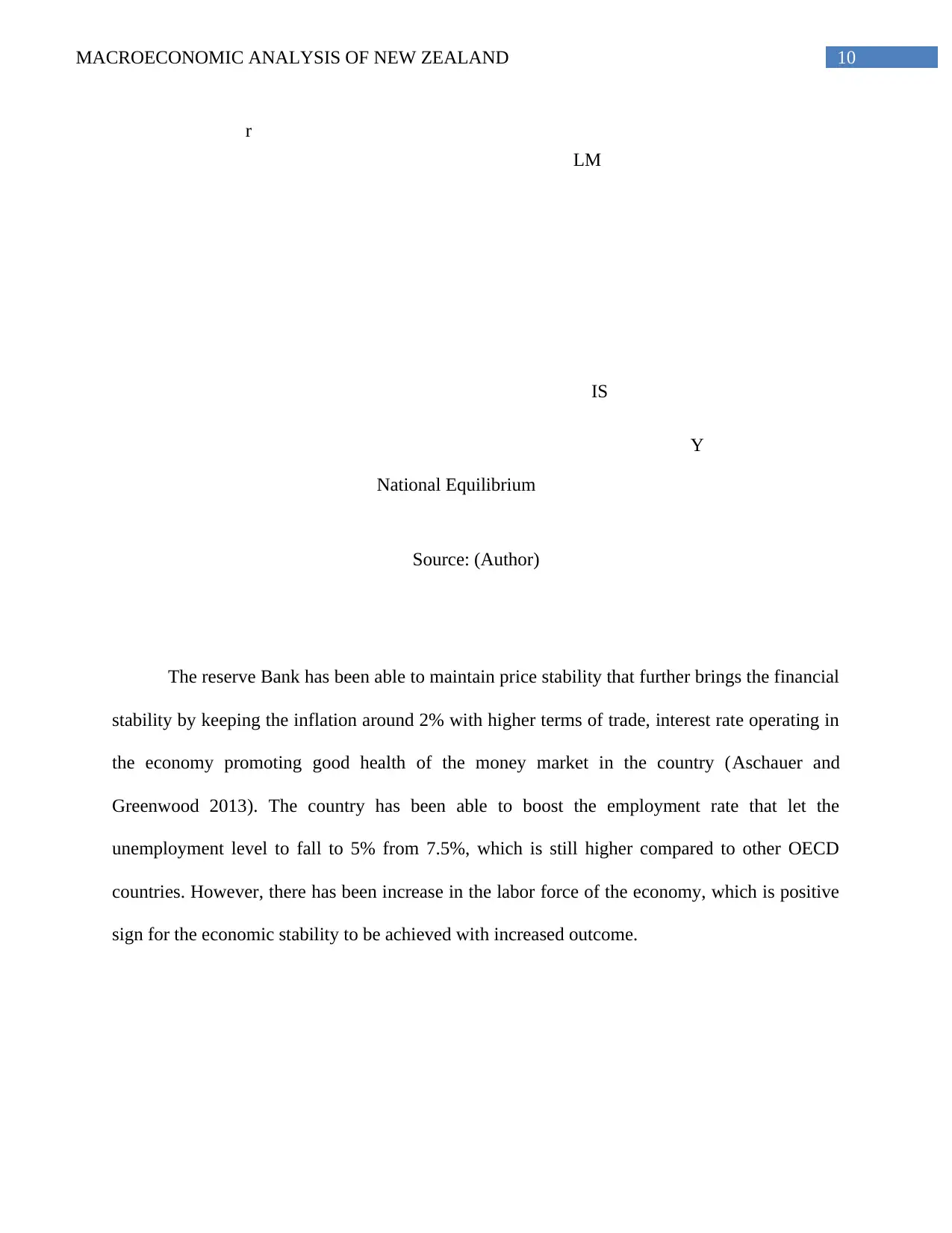
10MACROECONOMIC ANALYSIS OF NEW ZEALAND
r
Y
IS
LM
National Equilibrium
Source: (Author)
The reserve Bank has been able to maintain price stability that further brings the financial
stability by keeping the inflation around 2% with higher terms of trade, interest rate operating in
the economy promoting good health of the money market in the country (Aschauer and
Greenwood 2013). The country has been able to boost the employment rate that let the
unemployment level to fall to 5% from 7.5%, which is still higher compared to other OECD
countries. However, there has been increase in the labor force of the economy, which is positive
sign for the economic stability to be achieved with increased outcome.
r
Y
IS
LM
National Equilibrium
Source: (Author)
The reserve Bank has been able to maintain price stability that further brings the financial
stability by keeping the inflation around 2% with higher terms of trade, interest rate operating in
the economy promoting good health of the money market in the country (Aschauer and
Greenwood 2013). The country has been able to boost the employment rate that let the
unemployment level to fall to 5% from 7.5%, which is still higher compared to other OECD
countries. However, there has been increase in the labor force of the economy, which is positive
sign for the economic stability to be achieved with increased outcome.
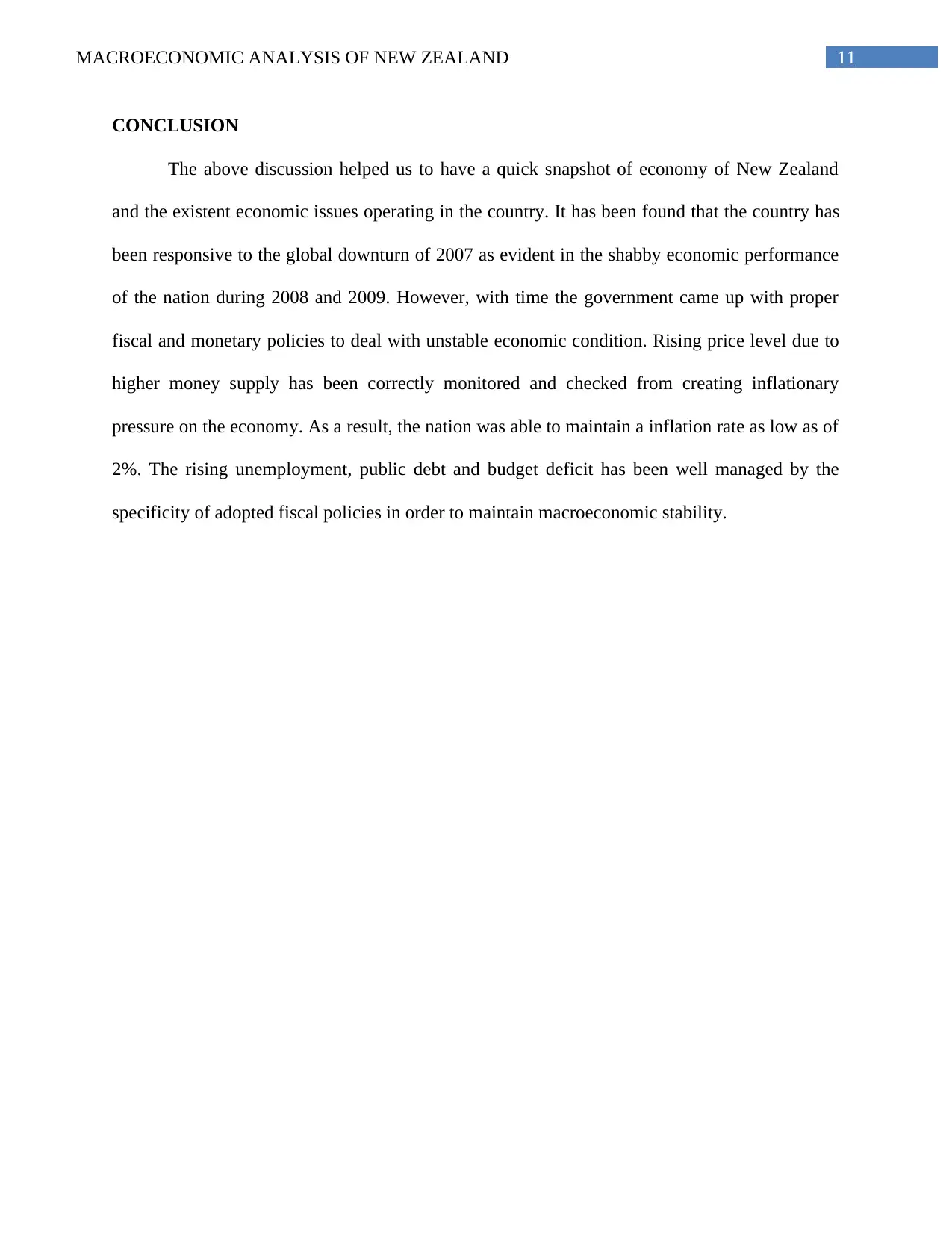
11MACROECONOMIC ANALYSIS OF NEW ZEALAND
CONCLUSION
The above discussion helped us to have a quick snapshot of economy of New Zealand
and the existent economic issues operating in the country. It has been found that the country has
been responsive to the global downturn of 2007 as evident in the shabby economic performance
of the nation during 2008 and 2009. However, with time the government came up with proper
fiscal and monetary policies to deal with unstable economic condition. Rising price level due to
higher money supply has been correctly monitored and checked from creating inflationary
pressure on the economy. As a result, the nation was able to maintain a inflation rate as low as of
2%. The rising unemployment, public debt and budget deficit has been well managed by the
specificity of adopted fiscal policies in order to maintain macroeconomic stability.
CONCLUSION
The above discussion helped us to have a quick snapshot of economy of New Zealand
and the existent economic issues operating in the country. It has been found that the country has
been responsive to the global downturn of 2007 as evident in the shabby economic performance
of the nation during 2008 and 2009. However, with time the government came up with proper
fiscal and monetary policies to deal with unstable economic condition. Rising price level due to
higher money supply has been correctly monitored and checked from creating inflationary
pressure on the economy. As a result, the nation was able to maintain a inflation rate as low as of
2%. The rising unemployment, public debt and budget deficit has been well managed by the
specificity of adopted fiscal policies in order to maintain macroeconomic stability.
⊘ This is a preview!⊘
Do you want full access?
Subscribe today to unlock all pages.

Trusted by 1+ million students worldwide
1 out of 14
Related Documents
Your All-in-One AI-Powered Toolkit for Academic Success.
+13062052269
info@desklib.com
Available 24*7 on WhatsApp / Email
![[object Object]](/_next/static/media/star-bottom.7253800d.svg)
Unlock your academic potential
Copyright © 2020–2025 A2Z Services. All Rights Reserved. Developed and managed by ZUCOL.





